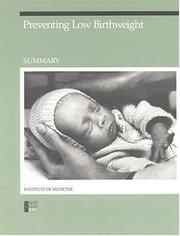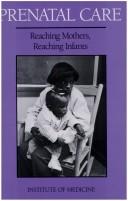| Listing 1 - 10 of 50 | << page >> |
Sort by
|
Book
ISBN: 3030519880 3030519872 Year: 2021 Publisher: Cham, Switzerland : Springer,
Abstract | Keywords | Export | Availability | Bookmark
 Loading...
Loading...Choose an application
- Reference Manager
- EndNote
- RefWorks (Direct export to RefWorks)
Parenthood. --- Prenatal care. --- Antenatal care --- Antenatal services --- Pre-natal care --- Pregnant women --- Maternal health services --- Preconception care --- Families --- Care
Book
ISBN: 9035224191 Year: 2001 Publisher: Maarssen Elsevier
Abstract | Keywords | Export | Availability | Bookmark
 Loading...
Loading...Choose an application
- Reference Manager
- EndNote
- RefWorks (Direct export to RefWorks)
605.5 --- obstetrie (verloskunde) --- prenatale raadpleging --- zwangerschap (graviditeit) --- Prenatal Care --- Handbooks --- zwangerschapscomplicaties --- Antenatal Care --- Care, Antenatal --- Care, Prenatal --- Pregnancy --- Preconception Care --- Prenatal Nutritional Physiological Phenomena
Book
Year: 2007 Publisher: Washington, D.C., The World Bank,
Abstract | Keywords | Export | Availability | Bookmark
 Loading...
Loading...Choose an application
- Reference Manager
- EndNote
- RefWorks (Direct export to RefWorks)
This paper analyzes the importance of strengthening the relationship of accountability between health service providers and citizens for improving access to and quality of health care. How this is to be achieved, and whether it works, however, remain open questions. The paper presents a randomized field experiment on increasing community-based monitoring. As communities began to more extensively monitor the provider, both the quality and quantity of health service provision improved. One year into the program, there are large increases in utilization, significant weight-for-age z-score gains of infants, and markedly lower deaths among children. The findings on staff behavior suggest that the improvements in quality and quantity of health service delivery resulted from an increased effort by the staff to serve the community. Overall, the results suggest that community monitoring can play an important role in improving service delivery when traditional top-down supervision is ineffective.
Antenatal care --- Clinics --- Community participation --- Family planning --- Health care --- Health Monitoring and Evaluation --- Health, Nutrition and Population --- Immunization --- Intervention --- Primary health care --- Primary schools --- Workers
Book
Year: 2007 Publisher: Washington, D.C., The World Bank,
Abstract | Keywords | Export | Availability | Bookmark
 Loading...
Loading...Choose an application
- Reference Manager
- EndNote
- RefWorks (Direct export to RefWorks)
This paper analyzes the importance of strengthening the relationship of accountability between health service providers and citizens for improving access to and quality of health care. How this is to be achieved, and whether it works, however, remain open questions. The paper presents a randomized field experiment on increasing community-based monitoring. As communities began to more extensively monitor the provider, both the quality and quantity of health service provision improved. One year into the program, there are large increases in utilization, significant weight-for-age z-score gains of infants, and markedly lower deaths among children. The findings on staff behavior suggest that the improvements in quality and quantity of health service delivery resulted from an increased effort by the staff to serve the community. Overall, the results suggest that community monitoring can play an important role in improving service delivery when traditional top-down supervision is ineffective.
Antenatal care --- Clinics --- Community participation --- Family planning --- Health care --- Health Monitoring and Evaluation --- Health, Nutrition and Population --- Immunization --- Intervention --- Primary health care --- Primary schools --- Workers
Book
ISBN: 0700014527 9780700014521 Year: 1970 Publisher: London Churchill
Abstract | Keywords | Export | Availability | Bookmark
 Loading...
Loading...Choose an application
- Reference Manager
- EndNote
- RefWorks (Direct export to RefWorks)
PREGNANCY COMPLICATIONS --- PRENATAL CARE --- Prenatal Care. --- Pregnancy Complications. --- Complications, Pregnancy --- Complication, Pregnancy --- Pregnancy Complication --- Pregnancy --- Obstetrics --- Perinatology --- Pregnancy, High-Risk --- Care, Prenatal --- Preconception Care --- Prenatal Nutritional Physiological Phenomena --- complications --- Antenatal Care --- Care, Antenatal --- Prenatal Care --- Pregnancy Complications

ISBN: 030903535X 9786610222308 1280222301 0309581494 0585144885 9780585144887 9780309035354 Year: 1985 Publisher: Washington, D.C. National Academy Press
Abstract | Keywords | Export | Availability | Bookmark
 Loading...
Loading...Choose an application
- Reference Manager
- EndNote
- RefWorks (Direct export to RefWorks)
Birth weight, Low --- Premature infants --- Prenatal care --- Growth. --- Antenatal care --- Antenatal services --- Pre-natal care --- Pregnant women --- Birth, Premature --- Infants (Premature) --- Preemies --- Preterm infants --- Low birth weight --- Care --- Maternal health services --- Preconception care --- Newborn infants --- Fetal growth retardation

ISBN: 0309038928 9786610214679 1280214678 0309542898 0585142866 9780585142869 9780309038928 Year: 1988 Publisher: Washington, D.C. National Academy Press
Abstract | Keywords | Export | Availability | Bookmark
 Loading...
Loading...Choose an application
- Reference Manager
- EndNote
- RefWorks (Direct export to RefWorks)
Prenatal care. --- Women's health services. --- Health services for women --- Women --- Antenatal care --- Antenatal services --- Pre-natal care --- Pregnant women --- Medical care --- Care --- Maternal health services --- Preconception care --- Services for
Book
Year: 2007 Publisher: Washington, D.C., The World Bank,
Abstract | Keywords | Export | Availability | Bookmark
 Loading...
Loading...Choose an application
- Reference Manager
- EndNote
- RefWorks (Direct export to RefWorks)
Promoting quality health services to large population segments is a key ingredient to human and economic development. At its core, healthcare policymaking involves complex tradeoffs between promoting equitable and affordable access to a basic set of health services, creating incentives for efficiencies in the healthcare system, and managing constraints in government budgets. International trade in health services influences these tradeoffs. It presents opportunities for cost savings and access to better quality care, but it also raises challenges in promoting equitable and affordable access. Drawing on a research project of the ASEAN Economic Forum, this paper offers a discussion of trade policy in health services for the ASEAN region. It reviews the state of healthcare in the region, existing patterns of trade, and remaining barriers to trade. The paper also identifies policy measures that could further harness the benefits from trade in health services and address potential pitfalls that deeper integration may bring about.
Antenatal Care --- Clinics --- Dentistry --- Health --- Health Monitoring and Evaluation --- Health Outcomes --- Health Services --- Health, Nutrition and Population --- Hospitals --- Immunization --- Infectious Diseases --- Medical Specialists --- Migration --- Nurses --- Nursing --- Patient --- Patients --- Pharmacists --- Physicians --- Primary Health Care --- Public Health --- Workers
Book
Year: 2009 Publisher: Washington, D.C., The World Bank,
Abstract | Keywords | Export | Availability | Bookmark
 Loading...
Loading...Choose an application
- Reference Manager
- EndNote
- RefWorks (Direct export to RefWorks)
Extreme weather events are known to have serious consequences for human health and are predicted to increase in frequency as a result of climate change. Africa is one of the regions that risks being most seriously affected. This paper quantifies the impact of extreme rainfall and temperature events on the incidence of diarrhea, malnutrition and mortality in young children in Sub-Saharan Africa. The panel data set is constructed from Demographic and Health Surveys for 108 regions from 19 Sub-Saharan African countries between 1992 and 2001 and climate data from the Africa Rainfall and Temperature Evaluation System from 1980 to 2001. The results show that both excess rainfall and extreme temperatures significantly raise the incidence of diarrhea and weight-for-height malnutrition among children under the age of three, but have little impact on the long-term health indicators, including height-for-age malnutrition and the under-five mortality rate. The authors use the results to simulate the additional health cost as a proportion of gross domestic product caused by increased climate variability. The projected health cost of increased diarrhea attributable to climate change in 2020 is in the range of 0.2 to 0.5 percent of gross domestic product in Africa.
Aging --- Antenatal care --- Epidemiology --- Food poisoning --- Health care --- Health effects --- Health indicators --- Health interventions --- Health Monitoring and Evaluation --- Health outcomes --- Health policy --- Health services --- Health, Nutrition and Population --- Isolation --- Morbidity --- Mortality --- Nutrition --- Nutritional status --- Public health --- Vaccination --- Victims
Book
Year: 2008 Publisher: Washington, D.C., The World Bank,
Abstract | Keywords | Export | Availability | Bookmark
 Loading...
Loading...Choose an application
- Reference Manager
- EndNote
- RefWorks (Direct export to RefWorks)
This paper examines the determinants of child nutritional status in seven provinces of China during the 1990s, focusing specifically on the role of two areas of public policy, namely health system reforms and the one child policy. The empirical relationship between income and nutritional status, and the extent to which that relationship is mediated by access to quality healthcare and being an only-child, is investigated using ordinary least squares, random effects, fixed effects, and instrumental variables models. In the preferred model - a fixed effects model where income is instrumented - the author find that being an only-child increases height-for-age z-scores by 0.119 of a standard deviation. The magnitude of this effect is found to be largely gender and income neutral. By contrast, access to quality healthcare and income is not found to be significantly associated with improved nutritional status in the preferred model. Data are drawn from four waves of the China Health and Nutrition Survey.
Antenatal care --- Health Monitoring and Evaluation --- Health services --- Health Systems Development and Reform --- Health, Nutrition and Population --- Immunization --- Influenza --- Medicines --- Nutrition --- Nutritional Status --- Population Policies --- Postnatal care --- Siblings --- Transport --- Transport Economics, Policy and Planning --- Walking
| Listing 1 - 10 of 50 | << page >> |
Sort by
|

 Search
Search Feedback
Feedback About UniCat
About UniCat  Help
Help News
News